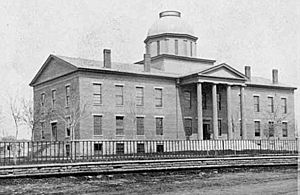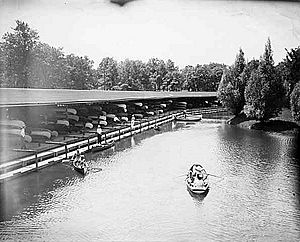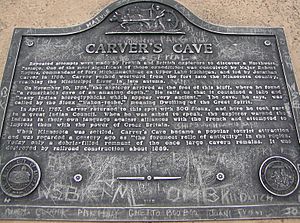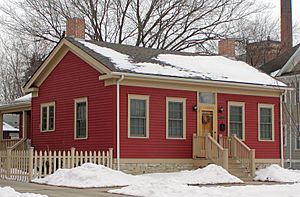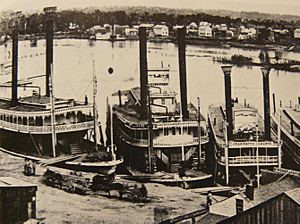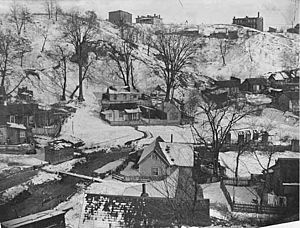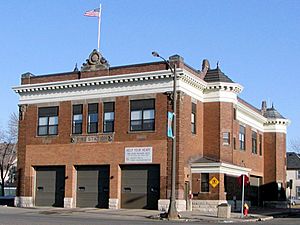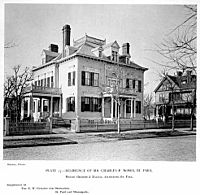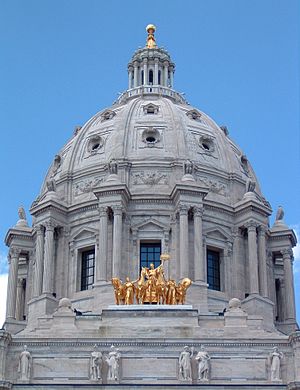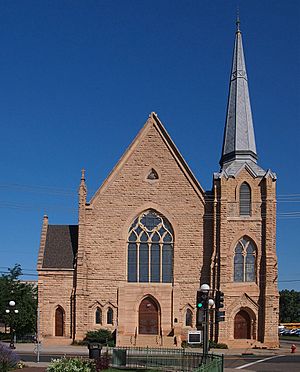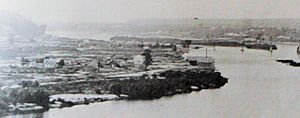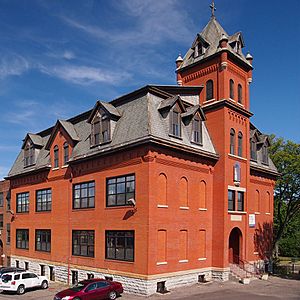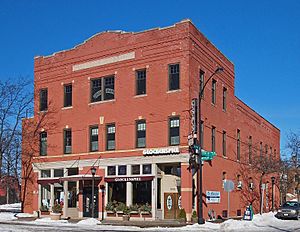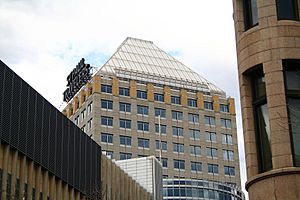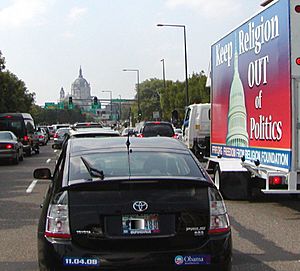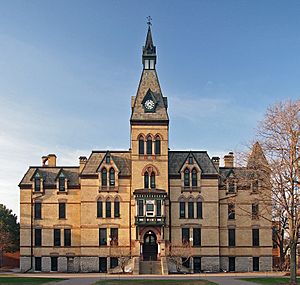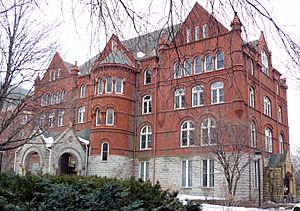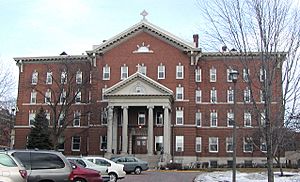History of Saint Paul, Minnesota facts for kids
Saint Paul is a big city in Minnesota, a state in the United States. It's the county seat for Ramsey County and also the capital city of Minnesota. The city grew because it was close to Fort Snelling, an early U.S. military base. It also sits on the Upper Mississippi River, which was a great spot for boats to stop.
Fort Snelling started in 1819 to help the U.S. control the fur trade on the Mississippi and Minnesota rivers. People who sold alcohol illegally were not allowed near the fort. One person, Pierre "Pig's Eye" Parrant, moved his business about 5 miles (8 km) downstream in 1838. This new spot became known as "Pig's Eye." In 1841, a priest named Father Lucien Galtier renamed the settlement "Saint Paul" after Paul the Apostle. By the early 1840s, Saint Paul was an important trading hub and a stop for settlers moving west. In 1849, it became the capital of the Minnesota Territory. Saint Paul officially became a city in 1854. When Minnesota joined the U.S. in 1858, Saint Paul became the capital of the 32nd state.
The natural land around Saint Paul helped it become a center for trade and travel. The Mississippi River here has tall stone bluffs on both sides. Saint Paul grew around Lambert's Landing, which was the last easy place for boats to unload cargo coming upriver. This made Saint Paul a main entry point for settlers heading to the Upper Midwest. In 1858, over 1,000 steamboats brought goods and people to Saint Paul. At first, a wagon road led from Saint Paul. Later, many railroads, like the Great Northern Railway, made Saint Paul their main office. For over a hundred years, Saint Paul was known as a frontier and railroad town. By the late 1900s, it became more focused on business and its role as the state capital.
The people who lived in Saint Paul shaped its unique feel. It started with Indigenous people who lived here for centuries. Throughout its history, many immigrants came, bringing their languages, religions, and cultures. People from French, French Canadian, German, Swedish, Irish, Czech, Austro-Hungarian, Polish, Italian, Mexican, Somali, and Hmong people backgrounds have all made Saint Paul their home.
Contents
- Geological History: How Saint Paul's Land Was Formed
- Native American History: The First People of Saint Paul
- Early Settlement: How Saint Paul Began
- Early Growth: 1849–1860
- Full Steam Growth: Saint Paul Expands
- The State Capitol: Minnesota's Government Building
- Religion: Churches and Synagogues in Saint Paul
- West Side: A Diverse Neighborhood
- 1904 Tornado: A Powerful Storm
- Twentieth Century: New Faces and Changes
- Recent History: Modern Saint Paul
- Higher Education: Learning in Saint Paul
- Images for kids
Geological History: How Saint Paul's Land Was Formed
Millions of years ago, shallow tropical seas covered much of southeastern Minnesota. During this time, layers of sedimentary rock formed the ground beneath Saint Paul. You can see these rocks today, like the St. Peter Sandstone and Platteville Limestone. These rocks sometimes contain fossils of ancient sea creatures.
About 20,000 years ago, huge sheets of ice called glaciers covered the area. These glaciers were incredibly powerful. They carved out deep valleys and left behind piles of rock and dirt called moraines. As the glaciers melted, they left behind large chunks of ice. When these melted, they created holes in the ground called kettles. These kettles later filled with water and became lakes like Lake Como and Lake Phalen.
A giant prehistoric river, Glacial River Warren, also helped shape the land. This river drained a massive ancient lake called Lake Agassiz. The powerful water from River Warren carved the wide valley where the much smaller Minnesota River and Upper Mississippi River now flow. This ancient river also created a huge waterfall, the River Warren Falls, near Saint Paul. Over time, this waterfall moved upstream, eventually splitting. One part became Saint Anthony Falls in Minneapolis. The tall bluffs along the river in Saint Paul show how much land the mighty River Warren carved away.
Native American History: The First People of Saint Paul
Around 2,000 years ago, the Hopewell culture, a group of Native American Mound builders, built as many as 37 burial mounds in the area. These mounds were used to bury their dead, often with special items, showing their religious beliefs. Later, the Dakota Indians also used these sites for burials.
Below the mounds was a large cave called Carver's Cave. The Dakota people called it "Wakân Teepee," meaning "sacred lodge." It was a special place with carvings of animals like rattlesnakes and bears on its sandstone walls. After a treaty in 1837, the Ojibwa people living on the bluffs moved to the west side of the Mississippi River. Soon, French fur traders and explorers began to settle in the area.
Early Settlement: How Saint Paul Began
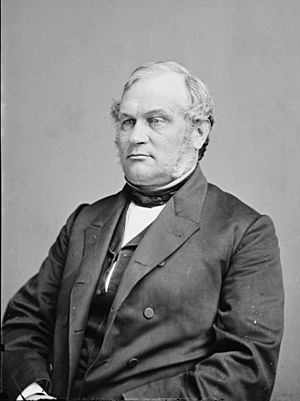
In the late 1700s, different countries claimed the land around Saint Paul. England claimed the east side of the Mississippi, while France and Spain claimed the west. Between the 1780s and 1800s, Spanish traders visited the region. From 1837 to 1848, Saint Paul grew from a few traders living in tents to a small town. In 1840, there were only nine cabins.
In 1841, Father Lucien Galtier built a Catholic chapel and named it Saint Paul's Chapel. This is why the settlement's name officially changed from "Pig's Eye" to Saint Paul. In 1847, Harriet Bishop, a school teacher, came from Vermont and opened the city's first school. She taught children from many different backgrounds. Harriet Island is named after her.
In 1849, the Minnesota Territory was officially created, and Saint Paul was named its capital. Alexander Ramsey, a politician from Philadelphia, became the first governor of the territory.
Early Growth: 1849–1860
After becoming the territorial capital, Saint Paul grew very quickly. Its population jumped from 900 people in 1849 to 10,000 in 1860. One visitor in 1849 described it as a "wild looking place" with many people living in wagons and tents. He noted that two large hotels were being built, along with many small wooden buildings.
Minnesota's first newspaper, the Minnesota Pioneer, started in Saint Paul in 1849. The Irvine Park neighborhood was planned in 1849, and Saint Paul's oldest house, the Charles Symonds House (1850), is there. Other old homes from this time still stand today. By the mid-1850s, a simple capitol building, a courthouse, and a small prison were built. The first bridge across the Mississippi River in Saint Paul, the Wabasha Street Bridge, was finished in 1859.
Many different groups of people came to Saint Paul. A large number of French Canadians moved to the city between the 1840s and 1930s. As the population grew, so did churches and cultural groups. German-Jewish pioneers started the city's first synagogue in 1856. In the early 1850s, the city's one Catholic church split into three groups: French, German, and Irish, who each held services in their own languages. By 1856, German Catholics built their own church, the Assumption Church. Schools like Baldwin School and the College of Saint Paul were founded, which later became Macalester College. The city's music scene began with informal concerts. In 1860, the first telegraph line reached Saint Paul, connecting it to the outside world.
Full Steam Growth: Saint Paul Expands
As Saint Paul grew, its docks were very busy. By 1860, Minnesota's population reached 200,000, and most people had arrived by riverboat in Saint Paul. Wealthy business owners began building large homes. The Burbank's Home (1862–1865) was one of the first mansions built on the bluffs of Summit Avenue. By the late 1800s, hundreds of impressive buildings filled areas like the Historic Hill District and Irvine Park Historic District, where rich and powerful people lived.
On the east side of the city, new immigrants from Sweden settled in a valley called Swede Hollow. Many lived in simple homes in the valley, which also provided water for businesses. Another similar community for Irish immigrants was called Connemara Patch.
In 1872, Horace Cleveland suggested a city-wide park system. Soon after, Lake Como was bought and became the center of Como Park, Zoo, and Conservatory. Later, Lake Phalen was also bought by the city in 1899.
By 1877, the city switched from volunteer firefighters to a paid fire department because of all the new buildings. Horse-drawn streetcars and even some cable cars traveled city streets by 1880. By 1891, electric streetcars replaced them all. New neighborhoods grew up along these streetcar lines.
In 1885, a reporter called Saint Paul "another Siberia" in winter. To prove them wrong, the Saint Paul Chamber of Commerce started the Saint Paul Winter Carnival. In 1886, the first Winter Carnival began, featuring an amazing ice castle made from Minnesota lake ice. This festival is now famous around the world.
Newspapers in different languages, like German, French, and Swedish, were popular. African-Americans read The Appeal, and Jewish immigrants read the Jewish Weekly.
By the early 1900s, some people felt uneasy about the newest immigrants. However, Saint Paul's historic Landmark Center, built in 1902, became an important building. It was once a federal courthouse and post office. Today, it's a beautiful arts and culture center. Important trials took place in this building.
The State Capitol: Minnesota's Government Building
Saint Paul is important because it's where the state government is located. Capitol buildings were built in 1854 and 1882. The third and current state capitol building was designed by Cass Gilbert. It looks like Saint Peter's Basilica in Rome. Its unsupported marble dome is the second largest in the world. The building cost $4.5 million and opened in 1905.
The outside is made of Georgian marble and Saint Cloud granite. Inside, the walls use 20 different types of stone. Above the main entrance is a gilded sculpture called the Progress of the State. Inside the rotunda, under the dome, is a large star representing the "North Star State." A huge crystal chandelier hangs above it. The building's rich decorations show the great wealth of the state at that time.
Religion: Churches and Synagogues in Saint Paul
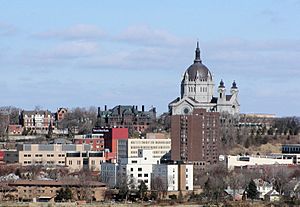
As Saint Paul's population and wealth grew, many impressive religious buildings were constructed. The most famous is the Cathedral of Saint Paul, which stands tall on the city's skyline. Its construction began in 1906. Its design allows visitors to see the altar and pulpit clearly.
Different groups of Catholics, like German, French, and Polish Catholics, built their own churches, such as the Church of the Assumption and the Church of Saint Louis King of France.
Protestants also built many churches. The Central Presbyterian Church was first built in 1854 and later enlarged. The First Baptist Church of Saint Paul was built in 1875 and was considered the largest and most expensive church in the city at the time. Many Lutheran churches were founded, some switching from Swedish or German services to English over time.
The Pilgrim Baptist Church is home to the first Black Baptist church in Saint Paul. It was started in 1866 by Reverend Robert Hickman and a group of escaped slaves who traveled up the Mississippi River with help from the Underground Railroad. By 1900, this group had helped create four more Black churches in the city.
Judaism has been important in Saint Paul since its early days. In 1856, eight German-Jewish merchants founded Mount Zion Temple. They were welcomed because they were Germans and early residents. By 1900, the Jewish population reached 5,000, with many new immigrants from Russia and Poland. Today, seven synagogues are in Saint Paul.
West Side: A Diverse Neighborhood
The West Side neighborhood is on the west side of the Mississippi River, south of downtown. For a long time, this land belonged to the Dakota people. After a treaty in 1851, it became available for settlement. Because of frequent flooding, few people lived on the "flats" (lowlands) before 1880. French-Canadians, Irish, and Germans lived on the higher banks and bluffs. In 1874, the West Side became part of Saint Paul.
In 1882, 200 Jews from Eastern Europe arrived, having escaped difficult situations in their home countries. They set up tents on the lowlands, which slowly became small houses. Over the next 30 years, more refugees from Russia, Lithuania, Poland, Syria, and Lebanon joined them. Synagogues and a Hebrew school were built.
After World War I, Mexican-Americans began to live on the flats. They came to Minnesota to work in meat packing plants and sugar beet fields. The Neighborhood House, a community center started by the Eastern European Jews, became a safe place for Mexican immigrants in the 1920s and 1930s. It offered classes and job help. As Jewish residents became wealthier and moved to higher ground, they rented their homes to Mexican immigrants.
Sadly, in the early 1960s, most of the historic buildings on the lower West Side were torn down for city development. However, many homes of wealthier residents on the high bluffs still stand. Today, the West Side is still home to Mexican immigrants, and the Neighborhood House continues to help residents. The community celebrates Mexican traditions with events like Cinco de Mayo.
1904 Tornado: A Powerful Storm
On August 20, 1904, Saint Paul was hit by strong thunderstorms and tornadoes. Many buildings were damaged or destroyed, costing $1.78 million in damages. Part of the High Bridge over the Mississippi River was blown down. Three people died and over 50 were injured downtown. Electrical lines were lost, making it hard to communicate and help people.
A wind measuring device on top of the Pioneer Press building recorded a sustained wind speed of 110 mph (177 km/h) with a gust of 180 mph (290 km/h). These are still Minnesota records today. It's not known if the damage was from a tornado or very strong straight line winds, but the winds were incredibly powerful.
Twentieth Century: New Faces and Changes
Over time, new groups of immigrants came to Saint Paul, including Czech, Slovak, Italian, Polish, Mexican, and Hmong people. In 1879, the Czech Slovak community bought land and built their first hall. Saint Paul's C.S.P.S. Hall is the oldest Czech-Slovak Hall in the United States and the oldest theater in Minnesota. It is now a historic site.
World War I brought strong anti-German feelings to the city. German language classes were stopped in schools, and German churches faced problems. Even common German foods like sauerkraut and hamburgers were temporarily renamed.
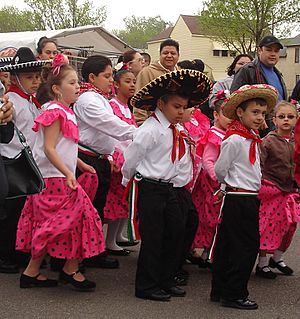
World War II created job openings for African Americans in the city. After the war, the G.I. Bill helped many Black residents get education and training. Sadly, Rondo Street, a lively neighborhood and center of the Black middle class, was destroyed to build Interstate 94. This caused great loss for the community. In 1968, Saint Paul experienced times of unrest and protest. This led to new laws and programs to fight racism.
Recent History: Modern Saint Paul
The West Side is still home to Mexican immigrants, including new arrivals. The Neighborhood House continues to support the community. Since a lock and dam system was finished in the 1950s, flooding on the West Side flats is rare. Good housing for families has been built there. The community works to keep Mexican traditions alive through music, dance, and history programs. The West Side celebrates Cinco de Mayo and Día de la Independencia each year.
As of 2004, almost 10% of Saint Paul's population were recent Hmong immigrants from Southeast Asia. Many came to Minnesota after the Vietnam War, seeking a new home. Like earlier immigrant groups, they speak their native languages and form close communities.
Saint Paul remains a financial center, with companies like The Travelers Companies headquartered there. Many large buildings in Lowertown have been turned into homes. Saint Paul's Xcel Center hosted the 2008 Republican National Convention in 2008, bringing many delegates and visitors to the city.
Higher Education: Learning in Saint Paul
Higher education has always been important in Saint Paul.
Hamline University (1854) was founded with money from Methodist Bishop Leonidas Lent Hamline. It first opened in Red Wing, Minnesota, but later moved to Saint Paul. The university closed during the Civil War but reopened in Saint Paul in 1880. Its oldest building, Old Main, was built in 1884. During World War I, Hamline had an Army Training Corps. After World War II, the university grew, adding new buildings and becoming known for its choir and theater programs.
Macalester College (1885) started thanks to Reverend Dr. Edward Duffield Neill. A businessman named Charles Macalester donated a building, and the college was officially chartered in 1874. It moved to its current location in 1885. Macalester began admitting women in 1893 and welcomed students of all faiths. After World War II, Macalester became known for its focus on internationalism, attracting students from around the world. The college continued to grow and add new facilities.
The University of St. Thomas (1885) began as a Catholic seminary for men. It became a liberal arts college in 1894. A gift from railroad owner James J. Hill helped create a separate seminary. The College of Saint Thomas became a military school for college students in 1906. It later stopped being a military school in 1922. During World War II, St. Thomas was a training base for naval officers, which helped keep the school open. After the war, housing was built for students and faculty.
Concordia University (1893) was founded by the Lutheran Church–Missouri Synod. It provides a Christian learning environment. Today, it has about 5,500 students learning in Saint Paul and online.
The first part of William Mitchell College of Law (1900) was founded by five important Saint Paul residents. Famous judges like Warren E. Burger and Harry Blackmun were connected to this law school.
The Saint Paul campus of St. Catherine University (1905) was founded by the Sisters of Saint Joseph of Carondelet. It was named after Saint Catherine of Alexandria.
Luther Seminary (1917) was formed by combining three institutions. It is part of the ELCA.
Images for kids


